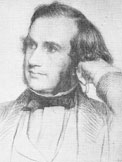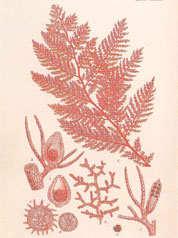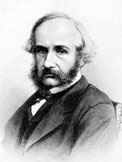William Henry Harvey (1811-1866)

Botanist, phycologist and systematist, was born on 5th Feb. 1811, at Sommerville, Limerick, the youngest of eleven children of Joseph Massey Harvey, a Quaker merchant, and Rebecca (neé Mark) also of that city. He was educated at Newtown, near Waterford and thence Ballitore, Co. Kildare (1824- 1827). Harvey was awarded an honorary M.D. from T.C.D. in 1844, before being elected F.L.S. (1857) and F.R.S. (1858).
Though initially interested in Molluscs his family's summer residence on the Atlantic coast at Miltown Malbay canalysed his interest to lower plants – especially algae. His discovery (1831) of Hookeria laetevirens, a moss species never before recorded from Ireland, led to a life-long friendship with Sir William Hooker, then at Glasgow but later director of Kew. In 1832 he undertook the algal account for J.T. Mackay's Flora Hibernica, (1835).
The deaths of his mother (1831) and father (1834) allowed Harvey to travel more freely. He was nominated by Thomas Spring-Rice for the post of Colonial Treasurer, Accountant General and Registrar of Deeds in the Cape Colony; however the appointment was made out in his brother, Joseph's, name; the government fell, the name could not be altered, and Harvey then accompanied Joseph and his family as unofficial assistant (1835). Joseph's severe depression led to his almost immediate return to Europe; his death en route led to William inheriting the post. William then spent 6-7 years at the Cape, interrupted by two trips home. He collected assiduously and began one of the works for which he is now famous, Flora Capensis, and published two others, The Genera of South African Plants and A Manual of the British Algae. The reoccurrence of severe depression finally caused him to return to Limerick (1842).

An hon. M.D. from T.C.D. failed to ensure his election as Professor of Botany, though he was appointed Keeper of the T.C.D. herbarium (1844). The latter job was highly suited to his talents and abilities – Harvey was exceptionally hard-working even by Victorian standards 'I rise at 5a.m. or before it, and work till breakfast time at the 'Antarctic Algae. … Again at plants till dusk' summarises a typical day. He presented his then herbarium of 10,000 specimens to T.C.D. Deeply committed to his job he spent at least one third of his salary purchasing books for the herbarium library to which they were all later willed as a gift.
Harvey was elected Professor of Botany of the R.D.S. (1848). In 1849 he undertook a lecture tour and collecting trip to America (where he made his well known 'Key West' collections). By delivering the Lowell lecturers at Boston he made the acquaintance of and became friends with Asa Gray, the best known American botanist of his day, and his wife. He published a popular work The Seaside Book (1849).
![Darwin’s copy of his field notes which he sent to Harvey with specimens. These show the collection number (2423) and the locality of collection Arch [epelligo] of Chonos, South of Chiloe [Chile]. (The same number and an abbreviated indication of locality also appear on the specimen.)](../../assets/img/william-handwritting.jpg)
In 1851 he completed Phycologica Brittanica (conceived in 1845) whilst, for much of that time, also working on another book Nereis Australis and, towards the end of that period, starting work on a third - Nereis Boreali-Americana. He also worked on specimens sent to him by Darwin from the Beagle, thereafter published in Flora Novae-Zeylandiae. He visited Switzerland with Hooker and J.P. Thompson (1852). He began an extended collecting trip (1853) which took him around the world. The majority of his time was spent in Australia but he also visited Gibraltar, Malta, Egypt (travelling, in part, overland to Suez as neither the Suez Canal nor railway from Alexandria to Cairo was completed), Trincomalee (Sri Lanka) where he met and befriended George Thwaites, Tasmania, Fiji, Darwin's copy of his field notes which he sent to Harvey with specimens. These show the collection number (2423) and the locality of collection Arch [epelligo] of Chonos, South of Chiloe [Chile]. (The same number and an abbreviated indication of locality also appear on the specimen.)
Tonga and Valpariso. On Fiji his guide was Koroe, whose name, Harvey was reliably informed 'was a title of honour only given to those who had committed at least five murders' . On Harvey's return to Ireland (1856) he was made Professor of Botany in T.C.D.. Election as a F.L.S. (1857) was swiftly followed by a F.R.S. (1858). He published Phycologica Australica (1858-1863) and Thesaurus Capensis (an illustrated supplement to Flora Capensis).

Harvey' s ability as a plant-collector was
formidable; in Australia he collected at least 20,000
specimens, (700 in one day at King George's Sound).
Gray commented in his obituary that 'he attracted
friends wherever he went' . His friendship with Gray
and W. Hooker allowed him free access to duplicate
specimens from Harvard, Kew and hence most of the
known world; any gaps were taken care of through his
acquaintance with the best known botanists of his day
(Darwin, Griffith, J.D. Hooker, Montagne, Spruce,
Ward) and purchase of key material. At least 100,000 specimens were added to the T.C.D. herbarium by Harvey. His book production is remarkable as not only did he collect the material, describe it and draw it, but also engraved the lithographs (he produced an average of one lithographic plate per week from 1856 till his death) and remarkably few changes were made by Harvey between the draft and final version of his book.
Agarum Turneri as illustrated (Plate V) in Nereis Boreali- Americana. Remarkably few changes were made
by Harvey between the draft and final
did heof his book. material, describe it and draw it, but also engraved the lithographs (he
stages collect the
produced an average of one lithographic plate per week from 1856 till his death).
A deeply religious man he was baptised (1846) into the Church of Ireland at
St. Mark's, Dublin. Though he admitted, both in writing and in lectures, that natural
selection may be the cause of much change he was reluctant to accept that species arose
through its action; nevertheless he retained Darwin' s esteem. His religious views were
published in 1862 as a letter to a friend Joseph Gough 'Charles and Josiah, or friendly
conversations between a churchman and a Quaker' .

One of his brothers included J.R. Harvey, Professor of Midwifery, Q.C.C. Following the death of his sister Hannah Todhunter, with whom he had lived at 19 Sir John’ s Quay, Dublin, and that of Mary Christy Harvey the daughter of his eldest and only surviving brother (1857) his loneliness increased. It was later ameliorated by his marriage (1861) to a childhood friend Elizabeth Lecky Phelps and move to 4 Winton Road, Dublin. Unfortunately and coincidentally his physical health declined; no children were born and he died of tuberculosis in Torquay where he was buried (15th May 1866). Many species of alga and one genus of higher plant (Harveya) are named after him.
Sources:
Papers and portraits are in T.C.D., the Royal Botanic Gardens Kew, other correspondence in Harvard and a portrait in the National Gallery of Ireland. L. Fisher, 'Memoir of W.H. Harvey, M.D., F.R.S.' (1869), (portr.); R.L. Praeger, 'W.H. Harvey' , Makers of British botany. A collection of biographies by living botanists, ed. F.W. Oliver (1913), 204-224 (portr.); S. Ducker, The contented botanist: letters of W.H. Harvey about Australia and Pacific, (1988), (portr.); J.H. Price, 'Goody two-shoes or a monument to Industry? Aspects of the Phycologica Brittanica of William Henry Harvey (1811 to 1866)' , Bull. Brit. Mus. Nat. Hist. (Hist. Series) (1988), 16: 90-216; E.C. Nelson, 'William Henry Harvey as Colonial Treasurer at the Cape of Good Hope: a case of depression and bowlderised history' , Arch. Nat. Hist. (1992), 19: 171-180; J. Parnell, 'William cares for nothing but weeds: William Harvey and Systematic Botany in Trinity College Dublin' , Treasures of the mind, ed. D. Scott (1992), 79-96, (portr.); P. Butler, 'William Henry Harvey, M.D., F.R.S., F.L.S.' , Irish botanical illustrators and flower painters, (2000), 108-111, (portr.). R.L. Praeger, 'Some Irish Naturalists'. A Biographical Note-Book, (1949 (portr.). J. Parnell